 Index
Index

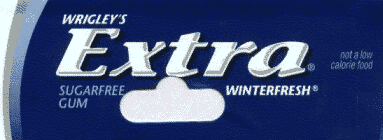
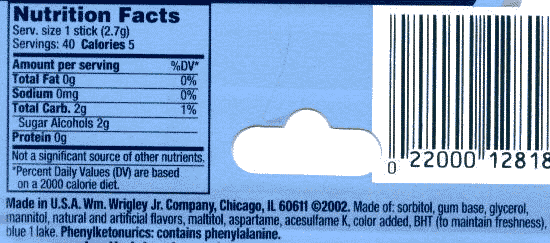
The word "sugar" is defined as: 1) sucrose which is a white crystalline sweet carbohydrate normally extracted from sugar cane and sugar beet, or 2) a generic term that includes any of a class of water-soluble carbohydrates with various degrees of sweetness. Using the first definition, manufacturers can claim that a product is "sugar free" if it contains less than 0.5 grams of sugar (sucrose) per serving. However, it can still contain other sweet carbohydrate mixtures such as molasses, dried cane juice, cane concentrate, high fructose corn syrup, or a variety of sugar alcohols like erythrol, mannitol, xylitol, etc.
Sugar alcohols occur naturally or may be produced by hydrogenation of monosaccharides and disaccharides. Sugar alcohols usually provide only two calories per gram, rather than four calories per gram like other carbohydrates. If you are not familiar with chemical nomenclature, the total carbohydrate and sugars in the Nutrition Facts label gives you a good idea of the actual amount of sugars in a product. The example above shows a "sugar free" gum that says in small letters "not a low calorie food" and lists 2 grams of "sugar alcohols" which are listed as sorbitol, mannitol, and maltitol in the ingredients. On a weight basis, 74% of this product is carbohydrate (2 grams out of 2.7 grams serving size).

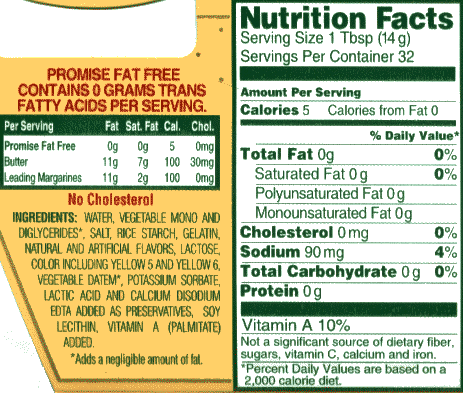
Fats are triglycerides. Some margarines claiming to have no fat contain monoglycerides and diglycerides as primary ingredients. Chemically, all these glycerides are esters of glycerol and fatty acids which are metabolized in exactly the same way. Monoglycerides and diglycerides, like normal fats, also have 9 Calories per gram. The FDA regulations require reporting fatty acids expressed as triglycerides. In a strict interpretation, monoglycerides and diglycerides are not considered "fat", and information about the saturation of their fatty acid components is omitted from the nutrition label.
This particular example shows the creative ways in which manufacturers exploit loopholes in the "Nutrition Facts" regulations to make ludicrous claims. Looking at the ingredients of Promise® Fat Free Nonfat Margarine we see that the first five ingredients are "water, vegetable mono- and diglycerides*, salt, rice starch, gelatin". Water and salt, of course, have no calories. The monoglycerides and diglycerides are not fat by the strict definition of fat, although the asterisk has a footnote that says that this ingredient "adds a negligible amount of fat", meaning triglycerides. The weight of the monoglycerides and diglycerides (and their Calories) are ignored because there is no reporting requirement. One serving of 14 grams has less than 0.5 grams of each: fat (triglycerides), carbohydrate (rice starch), and protein (gelatin). Therefore, all the values may be rounded to zero! Look at the Nutrition Facts: Total Fat 0g, Total Carbohydrate 0g, Protein 0g. A serving of 14 grams only has 5 reported Calories. Amazing!
We don't know the proportions of water and mono- and diglycerides, but we can make some estimates. We can assume that each serving has 0.4 grams of rice starch and 0.4 grams of gelatin because greater amounts would not produce zeros on the Nutrition Facts. These two ingredients have about 3 Calories. An additional 0.2 grams of triglycerides ("a negligible amount of fat") would supply the other 2 Calories. Added together, these ingredients have the 5 calories per serving reported on the Nutrition Facts. Let us now assume that a serving has 0.5 grams of flavorings, colors, and all other minor ingredients with no calories. Thus far, we have accounted for 1.5 grams of the 14-gram serving size. The remaining 12.5 grams are water and mono- and diglycerides, but in what proportion? Since water is the major ingredient, the weight of water has to be greater than the weight of glycerides, but if the proportion of water is too high, the product would be liquid rather than spreadable. Experience with cake frostings suggests that equal weights of water and butter can produce stable emulsions. If a serving has approximately 6.3 grams of water, the remaining 6.2 grams are mono- and diglycerides with 56 Calories that are not reported on the Nutrition Facts. So, a serving really has 61 Calories. The mono- and diglycerides constitute 44% of the weight of the product and are responsible for 92% of the calories, but on a technicality they remain hidden from the consumer. A high-fat food is passed off as a low-calorie food. Isn't this malevolently crafty? It is a very cruel joke played on people who count calories trying to lose weight.
This misinformation fools consumers and also organizations like the American Heart Association that certify products for nutritional content. To be certified by the AHA, a product serving must: 1) be low fat (less than or equal to 3 grams), 2) be low saturated fat (less than or equal to 1 gram), 3) be low cholesterol (less than or equal to 20 milligrams), 4) have a sodium value of less than or equal to 480 milligrams for individual foods, 5) contain at least 10 percent of the Daily Value of one or more of these naturally occurring nutrients: protein, vitamin A, vitamin C, calcium, iron or dietary fiber. If fatty acid glycerides were counted as "fat", which they really are, the product would not qualify for certification even if the product had only half of the glycerides estimated above. But this margarine has the AHA heart check mark and is recommended as a "heart-healthy food" in the grocery shopping list interface of the AHA web site.
It is no wonder that we get fat. We don't get accurate nutrition information from the manufacturers. To close this loophole, the Food and Drug Administration should define "total fat" to include all esters of glycerol and fatty acids that contribute at least five calories per serving. This definition would encompass monoglycerides, diglycerides, triglycerides, phospholipids and other lipids that contribute significantly to the total calories. The way things stand we don't know whether the fatty acids of the monoglycerides and diglycerides are saturated, unsaturated, or partially hydrogenated. The new definition would get rid of some of the zeros in the saturated, monounsaturated, and polyunsaturated subcategories of fat, and we would get a better idea of what we are eating. Also, the FDA should mandate that the "Calories" under the "Amount per Serving" should be calculated for all ingredients, regardless of whether they are fat, carbohydrate, protein, or anything else that does not fall in these categories.
The American Heart Association should not rely on the analysis provided by the manufacturer, but should run independent tests before granting a certification. In January 2004, I wrote to the American Heart Association questioning the certification procedure for a product that obviously does not meet their standards. The AHA attorneys asked me to remove the "heart check" symbol from my web site and did not provide any information about the certification procedure. (See letter in PFD format.) Clearly, the AHA has a conflict of interest. If they revoke the certification of this product, they lose the revenue that they get from the manufacturer for using their logo. And the consumers? -- Let them get fat!
The following illustrations show a sample of Promise Fat Free Nonfat margarine being heated in a water bath to melt the sample.


After melting, the sample was allowed to settle. These pictures show the separation of the water and lipid components. The curdled appearance of the bottom layer after two days indicates that the components have not yet settled completely. The sample was frozen and thawed twice and showed better separation on the third day. The clear upper layer has lipids that have a lower density than water, and the bottom layer consists of water, starch, and other components. Although complete settling has not been achieved by the third day, it is already evident that the upper layer of fat constitutes at least a third of the product. The initial estimate of approximately equal parts of lipids and water appears to be confirmed after six months of settling. The calories in the layer of fat are not reported on the nutrition label.

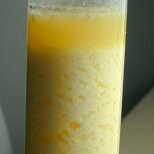


In December of 2003, I submitted a petition to the FDA requesting that "total fat" should include all esters of glycerol and fatty acids that contribute at least five calories per serving. In December of 2005, I received a response saying that there were not enough grounds for the FDA to modify the current definition of "fat free". The letter from Margaret O'K. Glavin, Associate Commissioner for Regulatory Affairs, stated:
... we have concluded that defining the term "fat" as you have requested is unnecessary. "Total fat" is the number of grams of total fat in a serving defined as total lipid fatty acids and expressed as triglycerides (21 CFR 101.9(c)(2)). Fatty acids are derived from triglycerides, diglycerides, monoglycerides, phospholipids, glycolipids, sterol esters and free fatty acids, and thus the declaration of "total fat" as the sum of all fatty acids expressed as triglycerides already takes into account all the possible sources of fatty acids in a food. Therefore, the manufacturer of the "Fat Free" margarine example that you included in your petition is not hiding the weight, calories and the fatty acid composition of monoglycerides and diglycerides by declaring "fats" as only triglycerides. [See the complete letter in PDF format (191K)]
The letter from the FDA states that the current definition "Total Fat" encompasses all forms of fatty acids expressed as triglycerides. The exact statement of 21 CFR 101.9(c)(2) is:
(2) "Fat, total" or "Total fat": A statement of the number of grams of total fat in a serving defined as total lipid fatty acids and expressed as triglycerides. Amounts shall be expressed to the nearest 0.5 (1/2) gram increment below 5 grams and to the nearest gram increment above 5 grams. If the serving contains less than 0.5 gram, the content shall be expressed as zero.
Unfortunately, the procedure for "expressing" the fatty acids as triglycerides is not defined. If a serving of a product has 3 grams of monoglycerides and 3 grams of diglycerides, how many grams of triglycerides should be reported? The answer cannot be too far below 6 grams. If we assume that half of the weight of the monoglycerides is due to glycerine, combining the fatty acids from the monoglyceride with the diglycerides to create triglycerides would yield 4.5 grams. The actual results would depend on the lengths of the fatty acid chains. Although the letter from the FDA says that the manufacturer is not hiding the weight of the monoglycerides and diglycerides by only reporting triglycerides, the question remains: How can a product that melts into equal parts of lipid and water be fat free?
One reader[1] recently pointed out that Promise Fat Free Nonfat Margarine pictured above is no longer available on supermarket shelves. The Promise® brand now belongs to Unilever, Englewood Cliffs, NJ 07632, and the packaging has changed. The American Heart Association logo is no longer on the package, but the logo of the World Heart Federation is used instead (a heart at the center of two concentric circular arcs). The words on the package say "Promise® Helps Maintain a Healthy Heart" inside two overlapping red and white elipses in the shape of a heart, and the words "Fat Free" and "No Trans Fat" are featured prominently. The package now says "Non-Hydrogenated", and the product has been slightly re-formulated:

The primary ingredients remain the same, but soy lecithin and several more vitamins have been added. The product still claims to have 5 calories per serving, zero calories from fat, and the mono- and diglycerides are still not acknowledged as fat or counted toward the total calories.
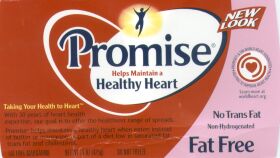
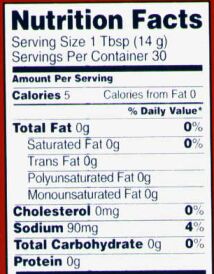
* On March 15, 2004, the heart-check mark on one of the products discussed here was removed from this web site at the request of the American Heart Association.
[1] Thanks to Norbert White for pointing this out.